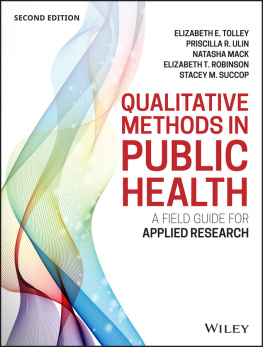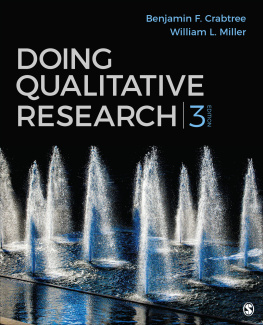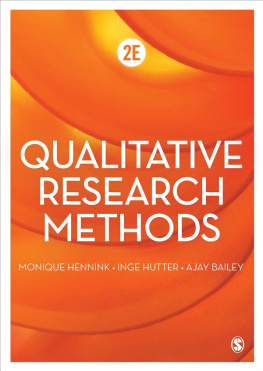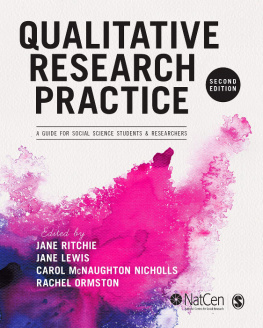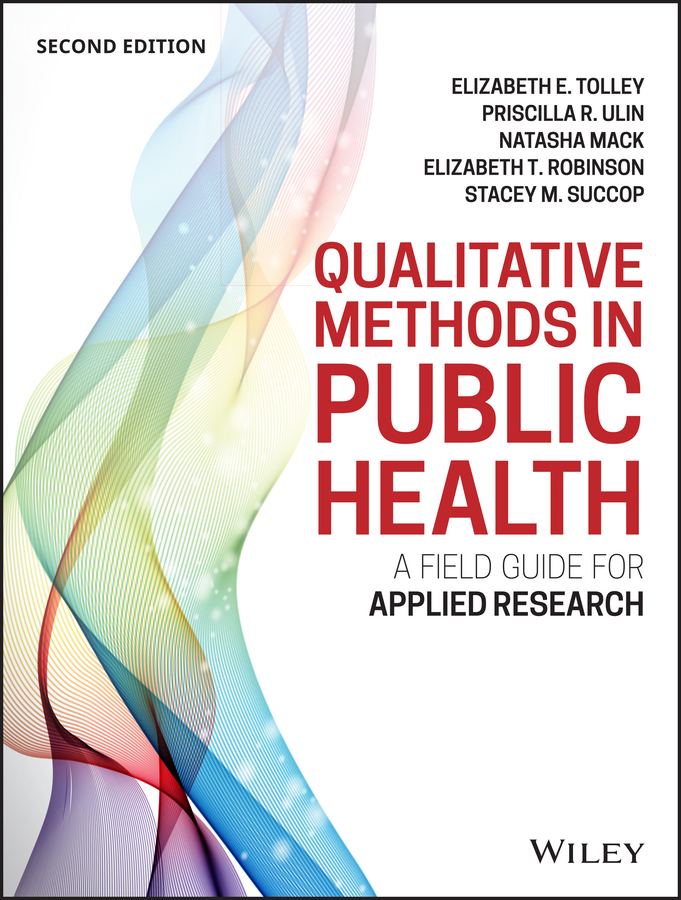
Copyright 2016 by John Wiley & Sons, Inc. All rights reserved.
First edition Qualitative Methods in Public Health: A Field Guide for Applied Research by Priscilla R. Ulin, Elizabeth T. Robinson, and Elizabeth E. Tolley 2005
Published by Jossey-Bass A Wiley Brand One Montgomery Street, Suite 1000, San Francisco, CA 94104-4594 www.josseybass.com
No part of this publication may be reproduced, stored in a retrieval system, or transmitted in any form or by any means, electronic, mechanical, photocopying, recording, scanning, or otherwise, except as permitted under Section 107 or 108 of the 1976 United States Copyright Act, without either the prior written permission of the publisher, or authorization through payment of the appropriate per-copy fee to the Copyright Clearance Center, Inc., 222 Rosewood Drive, Danvers, MA 01923, 978-750-8400, fax 978-646-8600, or on the Web at www.copyright.com. Requests to the publisher for permission should be addressed to the Permissions Department, John Wiley & Sons, Inc., 111 River Street, Hoboken, NJ 07030, 201-748-6011, fax 201-748-6008, or online at www.wiley.com/go/permissions.
Limit of Liability/Disclaimer of Warranty: While the publisher and author have used their best efforts in preparing this book, they make no representations or warranties with respect to the accuracy or completeness of the contents of this book and specifically disclaim any implied warranties of merchantability or fitness for a particular purpose. No warranty may be created or extended by sales representatives or written sales materials. The advice and strategies contained herein may not be suitable for your situation. You should consult with a professional where appropriate. Neither the publisher nor author shall be liable for any loss of profit or any other commercial damages, including but not limited to special, incidental, consequential, or other damages. Readers should be aware that Internet Web sites offered as citations and/or sources for further information may have changed or disappeared between the time this was written and when it is read.
Jossey-Bass books and products are available through most bookstores. To contact Jossey-Bass directly call our Customer Care Department within the U.S. at 800-956-7739, outside the U.S. at 317-572-3986, or fax 317-572-4002.
Wiley publishes in a variety of print and electronic formats and by print-on-demand. Some material included with standard print versions of this book may not be included in e-books or in print-on-demand. If this book refers to media such as a CD or DVD that is not included in the version you purchased, you may download this material at http://booksupport.wiley.com. For more information about Wiley products, visit www.wiley.com.
Library of Congress Cataloging-in-Publication Data
Names: Tolley, Elizabeth E., author.
Title: Qualitative methods in public health : a field guide for applied research / Elizabeth E. Tolley [and four others].
Description: Second edition. | San Francisco, CA : Jossey-Bass & Pfeiffer Imprints, Wiley, 2016 | Series: Jossey-Bass public health | Revision of: Qualitative methods in public health / Priscilla R. Ulin, Elizabeth T. Robinson, Elizabeth E. Tolley. c2005. 1st. ed. | Includes bibliographical references and index.
Identifiers: LCCN 2015042723 (print) | LCCN 2015042794 (ebook) | ISBN 9781118834503 (paperback) | ISBN 9781118834671 (pdf) | ISBN 9781118834657 (epub)
Subjects: LCSH: Public healthResearchMethodology. | Qualitative research. | BISAC: MEDICAL / Public Health.
Classification: LCC RA440.85 .U43 2016 (print) | LCC RA440.85 (ebook) | DDC 362.1072/1dc23
LC record available at http://lccn.loc.gov/2015042723
Cover Design: Wiley
Cover Image: Click Bestsellers/Shutterstock
Dedicated to Andy Pasternackour Jossey-Bass editor whose vision and encouragement inspired the first edition of this book.
List of Figures, Tables, and Boxes
Figures
- Strategic Communications Plan
- Flyer Disseminating Results from the LinCS 2 Durham Study to the Community
Tables
- Three Paradigms for Public Health Research
- Common Elements of a Research Proposal
- Summary of Sampling Approaches
- Structural Differences in Qualitative Data Collection
- Community Dissemination Formats and Audiences for the LinCS 2 Durham HIV Prevention Study
Boxes
- Characteristics of Qualitative Research
- Checklist for Evaluating Substantive Theory
- Social Ecological Model and the Position of Substantive Theories Along Concentric Levels of Aggregation
- Conceptual Framework: Social Drivers of Adoption of Improved Cook Stoves
- Common Ways to Mix Methodologies
- Priority-Sequence Model: Decisions for Integrating Methods
- Some Federal Requirements for Informed Consent
- Guidance for Conducting Direct Observations
- Using Participant Observation to Identify Recruitment Sites at Bars and Other Establishments for an HIV-Prevention Clinical Trial With Women
- Suggestions for How to Write Field Notes From Participant Observations
- Process for Constructing a Semi-Structured Question Guide
- Types of Qualitative Research Questions
- Levels of Interview Questions in a Qualitative Study of Emergency Contraception (EC)
- Deciding How Many Focus Groups to Conduct
- Collecting Background Information From Interview and Focus Group Participants
- Characteristics of a Good Interviewer or Moderator
- Common Errors in Focus Group Moderating
- Steps to Conducting a Focus Group
- Developing a Risk Management Plan
- Technology and Qualitative Research
- Illustrative Budget Considerations
- Qualitative Data Analysis: Step by Step
- Noting Content in Transcripts: An Excerpt From an Interview With a Peer Educator and Sex Worker
- Transcript Excerpt and Emergent Codes
- Preliminary Codebook
- Application of the Code Conflict by Two Coders
- Qualitative Intercoder Reliability Matrix
- What to Look for in Software for Qualitative Data Analysis
- Coding Report on Conflict
- Memo on Sexual Behavior
- Data Reduction Matrix Based on Sexual Behavior Coding Report
- Using a Diagram to Organize Findings
- Ways to Foster Two-Way Communication in Research
- Checklist: Elements of an Effective Communication and Dissemination Plan
- Working With the Media
- Using Social Media to Share Research
- How to Make Study Findings Accessible
- Dissemination Factors That Promote Utilization
- Policy Dissemination Tips
- How to Organize a Standard Scientific Article or Report
- Content Checklist: What to Include in Study Write-Ups
- How to Organize and Report Findings From Mixed-Method Studies
- Does Your Study Matter?
List of Case Studies
- : Prevent: Human Animal Exposure Study
- : Engaging Male Partners in Women's Microbicide Use
- : LinCS 2 Durham: Linking Communities and Scientists to Durham HIV Prevention
- : Sustained Acceptability of Vaginal Microbicides
- : Adolescent Women and Microbicide Trials: Assessing Challenges and Opportunities to Their Participation
- : A Field Assessment of Adoption of Improved Cook Stove Practices: Focus on Structural Drivers
- : Exploring Gender-Based Violence Among Men Who Have Sex with Men, Male Sex Workers, and Transgender Communities
- : Sociobehavioral Research and Community Planning to Develop Site-Specific Plans for PrEP Rollout
Next page
